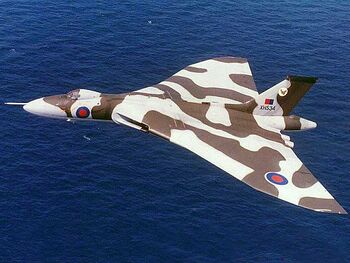
The Avro Vulcan was a British jet powered, delta-winged bomber, used only by the Royal Air Force. The first flight took place on 30th August 1952. It was in service from 1956 to 1984, and manufactured by A.V.Roe and Company (Avro).
History[]
Development[]
The story of the Vulcan began with a post war specification, which called for an aircraft to carry a 'special bomb' (nuclear weapon), of large linear dimensions, weighing 10,000 lb (4,536 kg) to a target 1,725 miles (2,780 km) miles away at a cruising speed of 576 mph (927 km/h), at heights of up to 50,000 ft (15,240 m). Still air range was to be 3,858 miles (6,209 km), and gross weight was not to exceed 100,000 lb (45,360 kg).[N 1] This final requirement focused the design team's attention on ways of reducing weight, which eventually led to the delta wing design, which was tested using the Avro Type 707.[1]
Service[]
Following reliability trials at Boscombe Down, two Vulcan B.Mk 1s were handed over to 230 Operational Conversion Unit at Waddington, south of Lincoln on 18th January, with No 1 course becoming A Flight of 83 Squadron on 21st May. As the first six production aircraft were acquired by the OCU, 83 Squadron did not begin to receive their aircraft until 11th July. Following the start of deliveries, 83 Squadron began training for the annual SAC bombing competition. The Vulcan force was expanded by the establishment of two additional squadrons - 101 at Finningley on 15th October 1957, and 617 at Scampton on 1st May 1958, with all three Vulcan bases being upgraded to Class One status.[N 2]
In July 1958, the RAF was incorporated into USAF strike plans, receiving US made Mk 5 nuclear weapons under the terms of Project E from October. These were used by the Waddington Vulcan units.[N 3]
In 1973 at least four B.Mk 2As were modified as SR.Mk 2As, serving with 27 Squadron on maritime reconnaissance duty between 1974 and 1982, with the bomb bay containing additional fuel tanks and classified reconnaissance equipment.[3]
The last Vulcans in RAF service were the six B.Mk 2 aircraft converted during 1982 to serve as K.Mk 2 inflight refueling tankers, using a Mk 17B Hose Drum refueling unit, until sufficient VC.10s could be converted for the inflight refueling role.[4] Operated by 50 Squadron RAF, who had previously used the aircraft as free fall bombers before conversion, the K.Mk 2s remained in service until 50 Squadron disbanded on 31st March 1984.[5]
Gallery[]
References[]
Notes[]
- ↑ No reason was given for this restriction.
- ↑ This resulted in the bases receiving longer runways, over run areas, increased bearing strength, hardstandings for 16 aircraft and special storage and security facilities for then nuclear weapons.[2]
- ↑ Also used by the Handley Page Victor Units at Honnington and Vickers Valiant units at Marham. Each base had 24 weapons in a US staffed compound, and remained under American control[2]
Sources[]
- ↑ World Aircraft Information Files Aviation Partwork. Midsummer Books Ltd. File 24 Sheet 1 (World Military Aircraft:Avro Vulcan - Introduction)
- ↑ 2.0 2.1 World Aircraft Information Files. File 24 Sheet 3 (World Military Aircraft:Avro Vulcan - Blue Danube to Blue Steel)
- ↑ Take Off magazine. Aerospace Publishing Ltd. 1994-1996. Aircraft Reference File 1062 (Royal Air Force Photo Reconnaissance Aircraft:Avro Vulcan SR.Mk 2A)
- ↑ World Aircraft Information Files. File 24 Sheet 4 (World Military Aircraft:Avro Vulcan - Low level, recce and tanking)
- ↑ World Aircraft Information Files. File 24 Sheet 5 (World Military Aircraft:Avro Vulcan - Vulcan operators)